Staying in this quiet mountain town and at the wonderful little Ryokan was definitely one of the highlights of the trip. The fact that we decided to visit Takayama at all was of course, all due to Paul and his indispensable travel blog. Ryori Ryokan Hanaoka was just the icing on the cake. Takayama is in Central Japan, in the Gifu Prefecture. It boasts a well-preserved old district, with beautiful machiya (merchant townhomes) as well as numerous centuries-old temples and shrines, many of which are accessible via a 3.5km loop north of the main town. The Ryokan is truly a short little trot from the JR Takayama Station – all told, some 5-6 blocks away by foot. Note that the proprietors adhere to checkin time, which is at 3pm sharp, though they will gladly hold your luggage for you prior to checkin.Because of the tsunami and earthquake, I think we may have been the only visitors there. Not once during our stay (albeit short) did we see another soul at the inn other than the proprietor and his wife. We first stayed for 2 nights during the first week of our trip and loved the food so much that we decided to spend another night in the town as we made our way to Tokyo towards the end of our journey. And indeed, the food was the distinct highlight of our bed and breakfast – it doesn’t make sense to skip out on the food if you choose to stay at this ryokan. We ate out the night of our arrival (more on that later) and the next day had a great Japanese breakfast and dinner in the evening.
We were lucky enough to get a 7-tatami mat room in the corner on the 3rd floor. It was roomy and spacious, with a small balcony and a bit of a view. On the 30th of March, we arrived to a sunny (but cool and windy) afternoon; the next morning we woke to a light dusting of snow on the buildings and cars outside.
Dinner is an amazing, sumptuous affair, a 13-course kaiseki highlighting local ingredients and specialities as well as showcasing seafood not usually easily procured in a mountain town. (Paul notes that most of the seafood is probably trucked in from Toyama Bay, some 80km away). The dish above was the sashimi course and consisted of Botan ebi (a kind of amaebi, sweet shrimp), Tai (sea bream), a bit of Aji (horse mackerel) and some awesome rolled ika (squid) and shiso.
I loved being able to sample the seasonal delights – especially the wild mountain spring vegetables, haru no sansai. For the Takiawase, or course where each ingredient is simmered separately we have fuki (butterburr) stems, some nanohana (rape blossom), takenoko (tender bambo shoots), shitake mushroom and salmon (hiding behind the veggies). The lower photo seems to be a ragout of marinated gyouja ninniku, a kind of japanese ramp, marinated in vinegar and served with a bit of clam. For more information on Japanese mountain spring vegetables see this great article by JustHungry’s Maki Itoh in the JapanTimes. Ms. Itoh also provides more photos and context on her blog here.
We probably encountered goma dofu first at Ryori Ryokan Hanaoka, and immediately fell in love with it. It tasted savoury yet sweet and nutty and I ended up saving it for one of my dessert courses. And of course when we returned home, we had to attempt to replicate it. To the left was eel terrine, bits of anago bound up in a firm gelatin or aspic, served with a dab of wasabi on top.
Also beautiful was the hassun – a melange of dishes designed to represent seasonal offerings from the land and sea. In this case we have a small pressed nigiri of cooked salmon or trout, a really tasty conch-type of shellfish called sazae (turban shell), some minced mountain greens, candied kumquat, edamame and sweet tamago behind the cooked shrimp in he center. Behind the hassun is grilled miso eggplant.
Another local speciality – beautifully marbled Hida Beef, served with assorted vegetables and local miso, and grilled on a small personal brazier tableside. The beef was uber tender and meltingly soft, even when cooked well-done. Vegetables were a mix of bean sprouts, spinach, green bell peppers and eggplant. Miso is a noted speciality in the area – because of its remote location and severe climate, foodstuffs were particularly hard to come by, and Hida region housewives became skilled at making miso, which provides a bit of protein in the lean times.
The soba buckwheat noodles arrived a bit late, almost as if the chef had nearly forgotten it, or had decided to make it at the last minute for us. It was served hot, in a delicious dashi broth, topped with nori and warabi fern stems. Delicious, but by the time it emerged, I was too full to finish it. (DD had no problem, though.)
Breakfast the next day was similarly delicious and generously portioned. 8 courses of tastiness including the distinctive Hoba Miso – a melange of miso, vegetables and katsuo boshi grilled on a hoba (magnolia) leaf – to be eaten on top of your rice, or rolled with rice and a sheet of nori. The main platter consisted of semi-dried and cured salmon, shoyu tamago, fishcake, and tangles of sweet-salty marinated seaweeds. To balance out the stronger flavors the chef provided some simple steamed broccoli, a sweet cherry tomato and orange slice. We loved the onsen tamago (slow cooked soft egg, with a firm yolk but almost runny white) with a bit of dashi and trefoil, as well as the dish of zenmai ferns, kitsune (fried tofu) and nanohana.
The Ryokan is amazingly priced at ¥5000 per person per night for rooms only. Adding breakfast and dinner brings you to the mind-boggling deal of ¥6600 per person per night including our own private bathroom (one is in essence paying about $20 more per person for 2 sumptuous, generously portioned and creative meals). Make sure to ask for a hair dryer (haru durai-ya) at the desk if you don’t see one in the room.
To reserve, I emailed the Takayama Ryokan Association in English, receiving a reply in English as well. On their website, the price for Ryori Ryokan Hanaoka is advertised at ¥8400 per person. However, the response I received from the association gave us the following pricing:
- 6600yen per person, with 2 meals(dinner and breakfast), including tax.
- 5500yen per person, with breakfst, including tax
- 5000yen per person, no meals, including tax.
Here’s more information on the Ryokan:
- Ryori Ryokan Hanoka
- 料理旅館花岡
- http://www7.ocn.ne.jp/~hanaoka2/
- Address: 2-36 Hanaokamachi Takayama, 506-0009
- Tel. 0577-34-4320
- Fax: 0577-34-9620
- Takayama Ryokan Association
We traveled to Takayama from Osaka on using our JR Passes and checking train schedules and routes with Hyperdia. We took a Hikari Shinkansen from the JR Shin-Osaka station (52 minutes), then transfering at Nagoya onto the Ltd Express Wideview Hida train (140 minutes) to Takayama proper. Exit from the train station where you’ll see the Takayama tourist information booth in front, and a Lawson to the left. Turn left on the street in front of you (you’re bearing west), passing the Nohi Bus Station. Walk 5-6 blocks – you’ll pass the huge Takayama City Hall on your right and in another few yards, you’ll see the 3-story Ryokan on your right as well.
As the proprietor let us know, and as we experienced for ourselves, things are fine, safe, and utterly delightful in Takayama. More photos are on my Flickr set here.

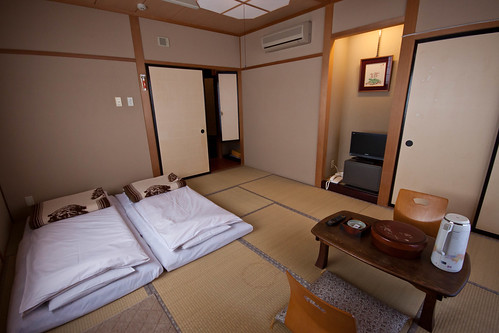
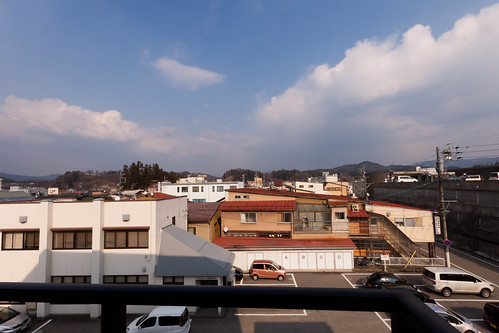

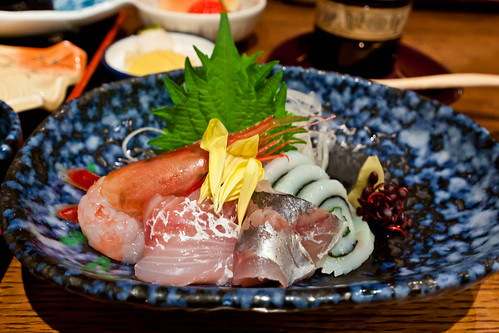
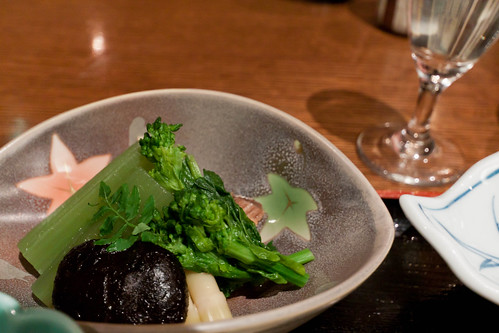
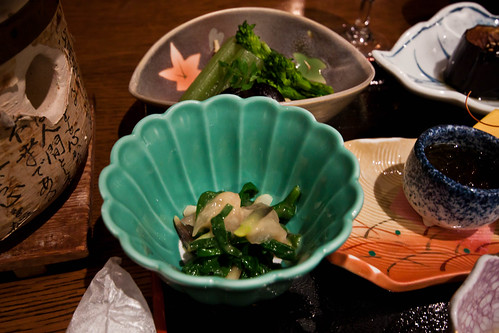

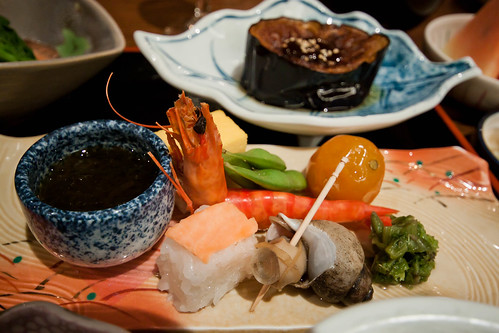
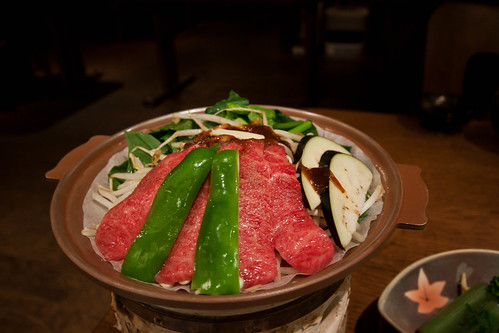
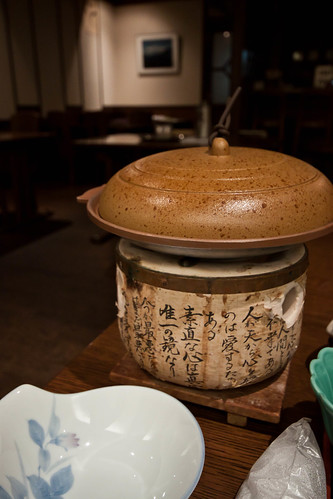



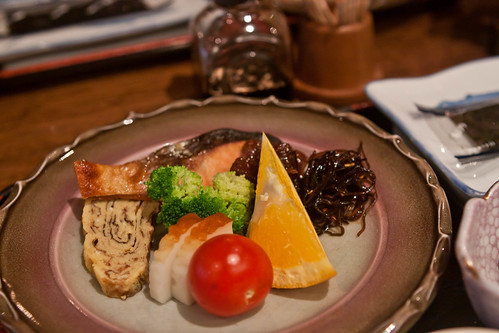

Pingback: Critique My Itinerary Please - FlyerTalk Forums()